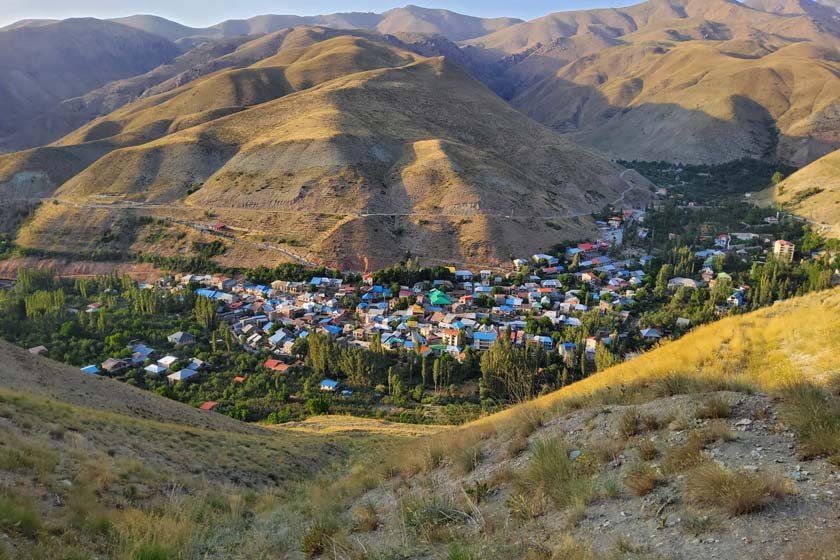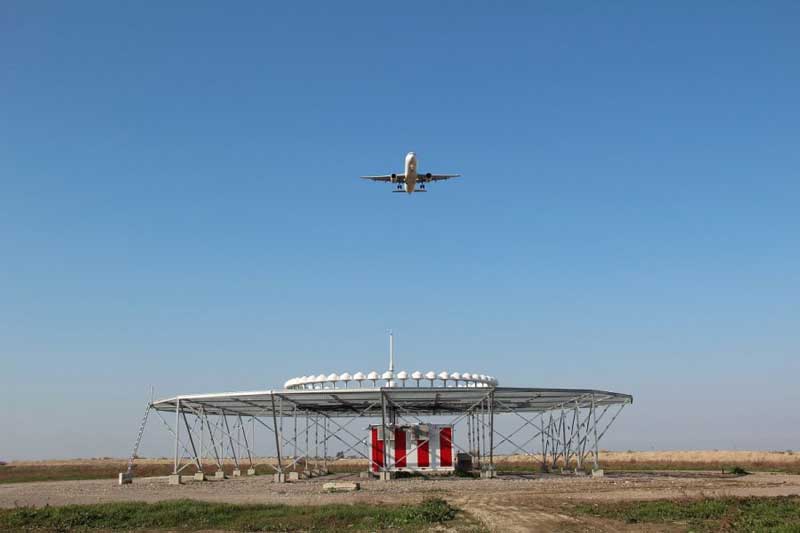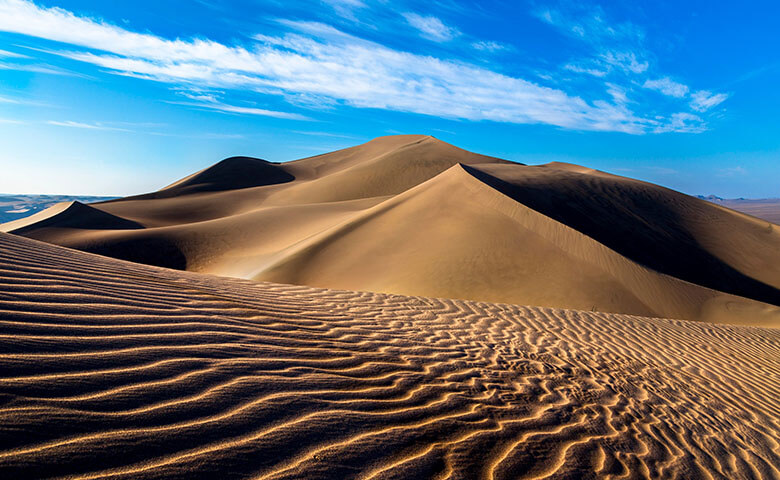A Glimpse into Shahrastank’s Heritage: Nature, Culture, and More
If you live in Tehran or Karaj and are fond of one-day trips in nature or mountain climbing, join us on a journey to Shahrastank. Let us take you on a memorable trip amid the yellow and orange trees of Shahrastank, a village with a rich historical and natural heritage. The old name of Shahrastank was “Shahrsonk,” and its history dates back to the 6th century AH (Islamic calendar).
The fertile land, suitable terrain, the perennial river of Shahrastank, and springs originating from the Central Alborz Mountains have kept this village alive. Despite being on the verge of abandonment, the unique beauty of Shahrastank still stands. During your trip to this village, you can not only enjoy nature, cycling, watching motorcyclists, picnicking, water activities, and photography but also explore the historical attractions of the area.
Here’s everything you need to know about Shahrastank:
1. Where is Shahrastank?
Shahrastank is a beautiful village in the Asara district, a suburb of Karaj, located in the Alborz province of Iran.
2. Distance from Tehran to Shahrastank:
Shahrastank is approximately 54 kilometers northwest of Tehran.
3. Access to Shahrastank:
The village is accessible via a mountainous road surrounded by green valleys, fruit orchards, and beautiful gardens.
4. Best time to visit Shahrastank:
The best time to visit Shahrastank is during the autumn season when the trees display vibrant colors.
5. History of Shahrastank:
Shahrastank has a rich history dating back to the 6th century AH, contributing to the cultural heritage of the region.
6. Flora and fauna of Shahrastank:
The village is blessed with fertile land, a suitable slope, the Shahrastank River, and springs originating from the Central Alborz, resulting in diverse plant and animal life.
7. Naseri Palace in Shahrastank:
Explore the historical Naseri Palace, a testament to the cultural and architectural heritage of Shahrastank.
8. River and Waterfall in Shahrastank:
Discover the Shahrastank River and its waterfall, adding to the natural beauty of the village.
9. Other tourist attractions in Shahrastank:
Visit other historical and natural attractions in the area to immerse yourself in the local culture and history.
10. Recreational facilities in Shahrastank:
Enjoy the available recreational facilities in Shahrastank, adding to the overall experience of your trip.
11. Accommodation and villas in Shahrastank:
Find suitable accommodation options and villas in Shahrastank for a comfortable stay during your visit.
12. Important tips for traveling to Shahrastank:
Receive essential travel tips to make your visit to Shahrastank enjoyable and hassle-free.
13. Culture of the people of Shahrastank:
Learn about the local culture and traditions of the people living in Shahrastank.
14. Photos of the village of Shahrastank:
View captivating photos of Shahrastank, showcasing its natural beauty and historical charm.
Embark on a journey to Shahrastank, where nature and history intertwine to create a truly unforgettable experience.
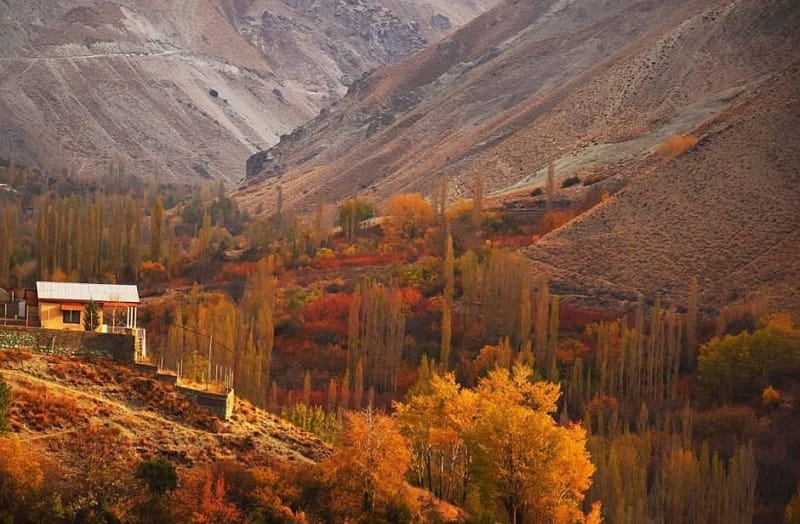
Shahrastank
Shahrastank is considered one of the attractions near Karaj, located in the beautiful village of Asara, within the Asara district of the Alborz region, near the city of Karaj in the Alborz province of Iran. In the past, Shahrastank was the center of the Kan district. However, when the Shemiran district became a separate district in the late 1326s, the villages of Erngeh, Lora, and Shahrastank were annexed to the Karaj district. This village is situated 54 kilometers northwest of Karaj, at the border of Alborz and Tehran provinces. With an elevation of 2,190 meters above sea level, Shahrastank captivates tourists and nature enthusiasts with its mountainous roads, lush valleys, fruit orchards, and beautiful gardens, particularly during the autumn season.
Shahrastank is bordered to the north by the village of Kasil and to the south by Ken, Solqan, and Imamzadeh Davood. It is also bounded to the east by Shokrab and Ahar, and to the west by Sark, Laniz, and Shelinak.
Location of Shahrastank
The distance from Tehran (Azadi Square) to Shahrastank via the Tehran North Freeway is approximately 60 kilometers, and the journey takes about one hour. If you choose to take the Chalous Road to Shahrastank, you will enjoy a scenic route with twists and turns, covering a distance of 84 kilometers in about two hours.
Access Routes to Shahrastank
To reach the picturesque village of Shahrastank, there are several access routes:
- By Personal Vehicle:
|From Tehran to Shahrastank via Karaj-Chalous Road: Head towards Karaj from Tehran, and upon reaching the city, take the Chalous Road exit. After traveling about 44 kilometers on the Chalous Road and passing through the villages of Asara, Mahan, and Dardeh, just before Gachsar, turn right onto the Shahrastank road. Follow the asphalt road for approximately 10 kilometers (about 10 minutes) to reach Shahrastank.
From Tehran to Shahrastank via Tehran-North Freeway: Start from Tehran on Sheikh Fazlollah Highway, exit before reaching the Tehran-North Freeway, at Azadegan Highway. From the beginning of this point, there is about a 50-kilometer route to Shahrastank. After passing through Azadegan Highway, which turns into Tehran-North Freeway after crossing Kharazi Highway, enter the Chalous Road, and take the Shahrastank Road exit after a few minutes on the left side. Follow the Shahrastank road for about 9 kilometers to reach Shahrastank. - Mountain Climbing and Hiking:
From Tochal Peak to Shahrastank: Trek westward from Tochal Peak towards Shahanshin Peak. After about an hour of hiking, you’ll reach Shahanshin Peak. From there, it takes approximately 1.5 hours to hike down to Shahrastank. The trail is easy and light, ensuring a pleasant journey. - Public Transportation:
Using Taxis or Buses to the North: If you prefer taxis or buses traveling northbound on the Chalous Road, disembark at the Shahrastank intersection, walk a short distance, and wait for passing vehicles. Keep in mind that finding suitable transportation for the return journey might be challenging, so it’s advisable to use organized tours from Tehran or Karaj or have personal transportation to Shahrastank, unless you are prepared to walk the remaining 9 kilometers from the roadside to the village.
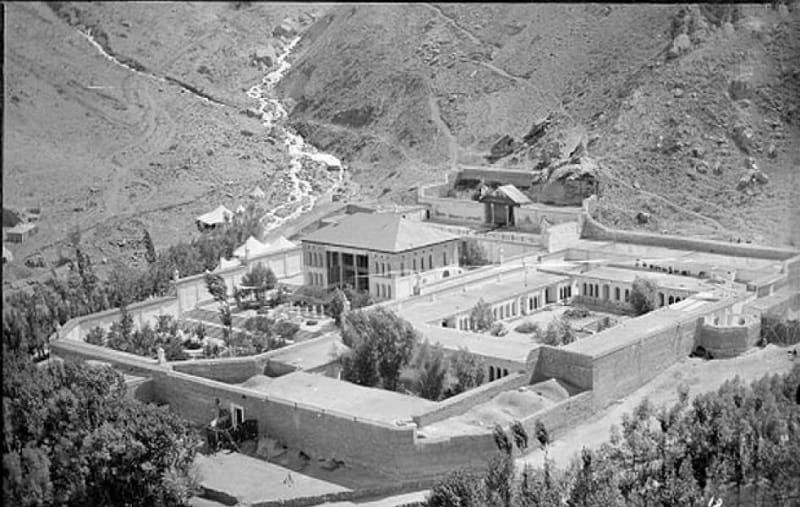
Recommendations for Shahrastank Travel:
If traveling by personal vehicle, it is recommended to park the car before entering the village and continue on foot.
For mountain climbing, the route from Tochal Peak provides a scenic and enjoyable trek.
If using public transportation, consider organized tours or personal transportation for convenience.
Embark on a journey to Shahrastank, where the blend of nature and history promises an unforgettable experience.
Best Time to Travel to Shahrastank
Shahrastank, with its moderate and cold climate, offers enchanting landscapes in each season, making it a destination worth visiting throughout the year. Here are the highlights for each season:
Spring in Shahrastank:
Ideal for those who enjoy the blossoming scenery with slightly cool weather.
Explore the village amid blooming mulberry and plum trees, taking a stroll through the greenery.
The village comes to life with vibrant colors, making it a refreshing experience.
Summer in Shahrastank:
Perfect for escaping the heat, as the weather is moderate and pleasant.
Enjoy the lush green trees and fruit orchards, creating a serene atmosphere.
Summer nights offer a delightful experience with cool temperatures.
Autumn in Shahrastank:
Considered one of the most beautiful seasons, with moderate temperatures.
Witness the mesmerizing spectacle of yellow and orange leaves on the trees.
The atmosphere becomes magical and mythical, creating unforgettable memories.
Local products, such as dried mulberries and plums, are available during this season.
Winter in Shahrastank:
Characterized by cold and snowy weather.
Ideal for those who appreciate the beauty of snow-covered trees.
If you don’t mind the cold, winter offers a unique charm to Shahrastank.
Historical Background of Shahrastank
Shahrastank, a village with a history dating back around 4000 years, owes its formation to a permanent river and abundant water resources in the region. According to locals, the village was established in the 6th century, supported by archaeological findings.
Until a few decades ago, the village was surrounded by smaller settlements, which gradually disappeared due to the favorable climate and fertile soil of Shahrastank. The village thrived as the primary settlement in the area.
Flora and Fauna of Shahrastank
Shahrastank boasts a variety of medicinal herbs and vegetables, including pennyroyal, saltwort, mountain mushrooms, rewas, and more. The captivating scents of these plants and vegetables permeate the air, providing a sensory delight to visitors.
The fauna in Shahrastank includes foxes, jackals, hares, deer, wolves, sheep, goats, mountain goats, and partridges.
Naseri Palace (Shahrastank Palace)
Naseri Palace, also known as Shahrastank Palace, is a historical building in the Alborz province, constructed during the reign of Naser al-Din Shah Qajar in the 19th century. The palace, built for the Shah’s relaxation and hunting purposes, showcases remarkable architecture.
The construction of the palace began in 1878 and continued until 1881. Renowned architect Agha Mohammad Ibrahim, known as “Master Bashi,” oversaw the project. Naser al-Din Shah used to visit Shahrastank annually, holding a special ceremony called “Aashpazan” (Chefs) in the village.
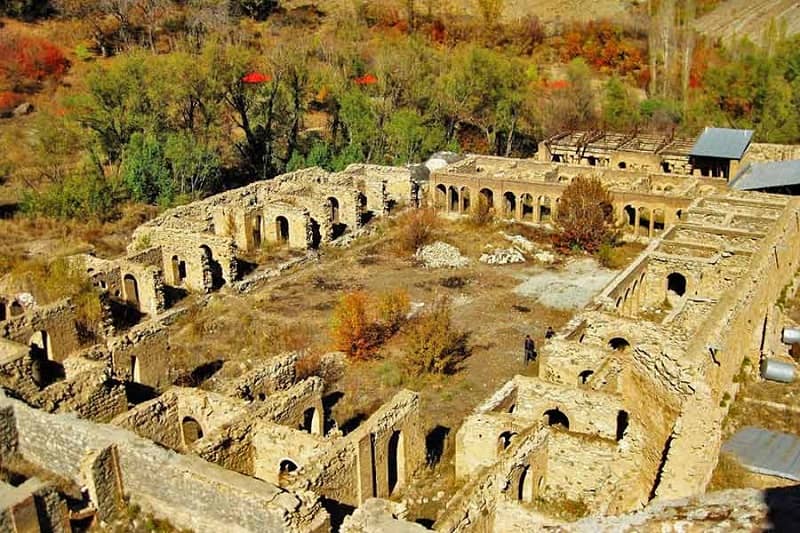
To reach Shahrastank, the Shah had to navigate a specific carriage road known as the Shahi Carriage Road, passing through the Tochal peak and the city of Shahrastank. However, this journey was perilous for the numerous servants accompanying the Shah, as they had to traverse a narrow and dangerous path along the river. It is said that over 1500 Shah’s servants lost their lives during these journeys. Consequently, Naser al-Din Shah ordered the construction of a palace called “Yaqut Palace” in Sarkeh Hasar, where the Chef’s ceremony was later relocated.
Visiting Shahrastank offers a unique blend of natural beauty and historical significance, providing an unforgettable experience for travelers.
Architecture of Naseri Palace
Naseri Palace is divided into two sections: internal and external, within an 8,000 square meter compound. The external complex features a rectangular courtyard designed on four levels. The royal entrance, shaped like a semicircle, was situated on the first level. The Diwan-khaneh building, a two-story structure adorned with German oil-painted wallpapers and gypsum ceiling decorations, was located on the fourth level.
The external mansion, measuring 12 by 24 meters on the third level, has had its second floor demolished over time. In the northwest section of Naseri Palace, near the border between the internal and external sections, there was a private bath for the king. The internal section consists of two courtyards built in a circular manner due to the slope, with a three-meter elevation difference between them.
The northern or lower courtyard, measuring 18 by 24 meters, served as the residence for the servants. The southern courtyard, measuring 26 by 40 meters, was used as the sacred sanctuary. The internal section resembles a caravanserai, especially in the southern courtyard. In total, 19 rooms are visible in the northern and eastern sections of the building.
Current Status of Naseri Palace
Naseri Palace, despite its gradual deterioration and human neglect, remains the most important historical and tourist attraction in the village of Shahrastank. However, visitors should not expect to encounter a magnificent structure. Unfortunately, over time, adverse weather conditions, plundering, and human destruction have turned Naseri Palace into ruins, with its walls now covered in inscriptions from tourists.
Notably, one of the buildings of Naseri Palace was reconstructed in 1969 during the Pahlavi II era, becoming a temporary accommodation for mountaineers. It was registered as a national heritage site on September 6, 1997, with the number 1925.
The shrine building of Naseri Palace, buried under the ground for a long time, gained attention in the 1980s. Its foundations were unearthed, and part of the ruined walls underwent restoration and reconstruction.

Access to Naseri Palace
To reach Naseri Palace, a lengthy 6.5-kilometer trek to the south of Shahrastank, towards the mountainous heights, is required. The journey takes approximately two hours on foot. Mountaineers approaching Shahrastank from Tochal will encounter Naseri Palace as their first stop. After leaving the village and heading towards the gardens of Shahrastank, you will find a warning sign preventing non-locals from entering by car. However, access is possible on foot, guided by several informational signs along the way.
Despite the fact that little remains of the palace today, walking the path and stepping among the ruins of a once beautiful and magnificent structure is worth the long trek. There is hope that Naseri Palace will undergo reconstruction and that the remnants will be preserved.
Visiting Hours: Visitation to the palace is only possible on Saturday mornings.
Ticket Price: Free
Address: Kilometer 55, Karaj-Chalus Road, Shahrastank Village
River and Waterfall of Shahrastank
Tall trees reaching for the sky, alongside the enchanting sound of the flowing water of Shahrastank River, captivate onlookers effortlessly. The relatively abundant Shahrastank River passes through the center of the village and eventually joins the Karaj River. You can enjoy the beautiful nature surrounding the river and its clear, pure water, capturing stunning photos. The river originates from the Gol Kileh Spring, located upstream from the Naseri Palace.
The path of this river, before reaching the Karaj River, is approximately 15 kilometers long, surrounded by trees that stand proudly beside the soul-soothing sound of the flowing water. Playing in the Shahrastank River is one of the most enjoyable activities to experience in this village. However, it is essential to always be aware of the river’s depth and potential hazards.
Along the path to the Naseri Palace, before reaching the Gol Kileh Spring, there is a low and wide waterfall that, when visited, imparts extraordinary freshness and vitality.
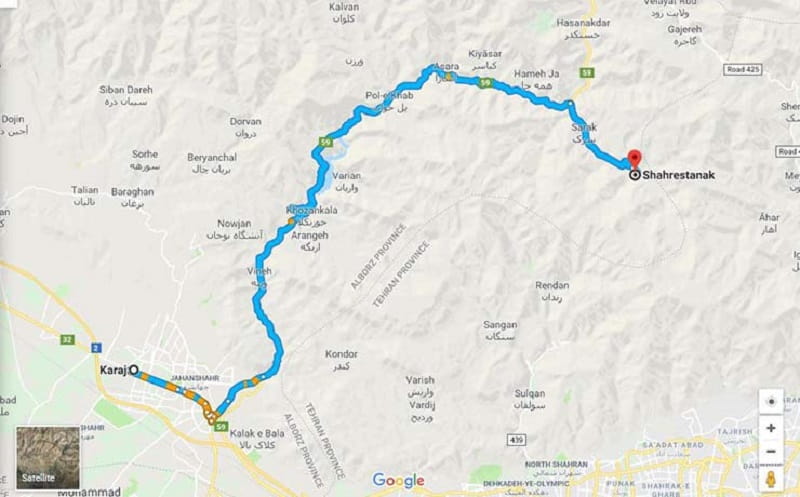
Other Tourist Attractions in Shahrastank
1.Shahrastank Inscription
Next to the Shahrastank Palace, there is a large stone piece with a height of over four meters, featuring an inscription. According to the villagers, during Naser al-Din Shah’s rest at the palace, this stone separated from the cliff overlooking the palace without causing any damage and was placed next to the palace. After this incident, the Qajar king ordered the story of this event to be engraved on the stone. However, the inscriptions on the stone are not easily readable, and you can only capture a souvenir photo next to it.
2.Dezdband Castle in Shahrastank
Dezdband Castle, also known as the Girl’s Castle, is situated on the Alras Mountain ridge, above its highest peak, in Shahrastank. Currently, only the foundations of three rooms and part of the ceiling of one of its rooms remain.
The materials used for building Dezdband Castle were local stones and Sarooj mortar, with its interior covered in gypsum. From the remaining structure, it can be deduced that this place was not a castle but rather used for observation and communication. Apparently, guards and lookouts communicated with each other through lighting fires or lanterns with oil inside this structure.
Examination of collected pottery from inside and around the building and the study of the castle’s map, plan, and architectural style indicate that it is an Islamic structure, likely dating back to the Ilkhanid or Timurid period. Researchers’ findings suggest that the pottery used in this place was utilitarian and not decorative.
3.Access Route to Dezdband Castle in Shahrastank
To reach Dezdband Castle, you must ascend from the left side of Shahnesin Mountain. This path requires about half an hour of mountaineering, so if you lack mountaineering experience, it is advisable not to climb this path.
4.Shenestoon Hill
Shenestoon Hill, or “Shen Stan,” is located in the southern part of the Gol Kileh Valley in Shahrastank, with a collection of red-colored pottery where fruit orchards at the top of the mountain end. Shenestoon’s lands were previously used for rainfed agriculture, explaining the scattered conglomerations of rocks in the mountain’s foothills.
As historically, graveyards were often built in mountain foothills, and since red-colored pottery belonging to that era exists in Shenestoon Hill, it can be speculated that the site dates back to historical nomads.
5.Ours Cedar Tree
The ancient Ours Cedar tree, locally known as “Horst,” is approximately several hundred years old, with a height of around 17 meters and a width of about 14 meters. To reach this ancient tree, you need to walk about 20 minutes southeast of the village on a dirt path. If you can’t find the way, ask the locals for guidance. The Shahrastank municipality is currently constructing a more suitable path for accessing this ancient tree.
Some believe that the Shahrastank Ours Cedar, with an estimated age of 2800 years, is one of Iran’s oldest living beings, preserving the glorious history of Iran from before the Achaemenid Empire to the present day.
6.Gol Kileh Spring
After a not-so-long journey of about 20 minutes from Naseri Palace, you will reach a refreshing spring called Gol Kileh. This spring originates from beneath a rock and eventually flows into the river. If you plan to have lunch, it’s a good idea to sit around the Gol Kileh Spring. The beautiful view of walnut, cherry, and plum trees around the spring adds to the joy of a few hours of relaxation for your lunch break.
It’s important to note that to reach the palace and Gol Kileh Spring, you’ll have a long hiking distance ahead. Still, if you make it to Naseri Palace, make sure to visit this spring and enjoy the beauty of its surrounding nature.
Facilities in Shahrastank
If you’re planning a day trip to Shahrastank, it’s best to start early in the morning and explore this beautiful village until the evening. When traveling to Shahrastank, it’s advisable to bring your own meals, as there might not be a store or shop with all the necessary items in the village. The local yogurt and cheese in Shahrastank are renowned, so don’t miss the opportunity to taste them.
Facilities in Shahrastank include the Grand Mosque, Sahib al-Zaman Mosque, Safa Mosque, Hussainiyya Shuhada, a health center within the village, camping facilities in the form of tents, several sanitary facilities, and a small cafeteria near the Naseri Palace. You can use the mosques for prayers and access the sanitary facilities.
Accommodation and Villas in Shahrastank
Accommodation facilities such as hotels or guesthouses are not available in the village of Shahrastank. However, you can stay in nearby cities such as Tehran, Karaj, Marzanabad, etc., and travel to Shahrastank for a one-day trip.
You may also consider camping in the tents around the village or near the Naseri Palace. Ensure that your choice of camping site does not violate the fruit orchards’ boundaries and does not cause inconvenience to the village residents.
Important Tips for Traveling to Shahrastank
Harvesting fruit from the people’s orchards without permission is not acceptable. If you wish, you can purchase their products. Keep in mind that entering orchards without permission creates tension between locals and tourists, causing serious issues.
Exploring Shahrastank is mainly done on foot, so be prepared with suitable footwear and clothing. Be aware that there are limited recreational facilities in Shahrastank, so try to bring all necessary items for your trip.
There are no accommodation facilities in Shahrastank, so it’s recommended to stay in nearby cities and plan a one-day trip to Shahrastank.
Traveling in Shahrastank is mainly on foot, so be prepared with comfortable shoes and suitable clothing. Also, consider bringing sunscreen, as well as rain gear, depending on the weather.
There are limited signboards in Shahrastank, so it’s advisable to find your route beforehand using Google Maps or a map. Alternatively, seek assistance from the locals. Consider joining a guided tour for the best experience in this area.
Essential Items for Traveling to Shahrastank
One of the most popular recreational activities in Shahrastank is hiking, so bring appropriate clothing and footwear, rain gear, suitable shoes, sunglasses, sunscreen, and, if interested, hiking poles. Keep in mind that there are limited recreational facilities in the village and on the hiking route.
Food, drinking water, a mat, snacks, a trash bag, essential medications, cash, a mobile charger, a power bank, a travel tent, firewood, charcoal, matches, a windbreaker, and a blanket and sleeping gear are among the essential items for traveling to this village.
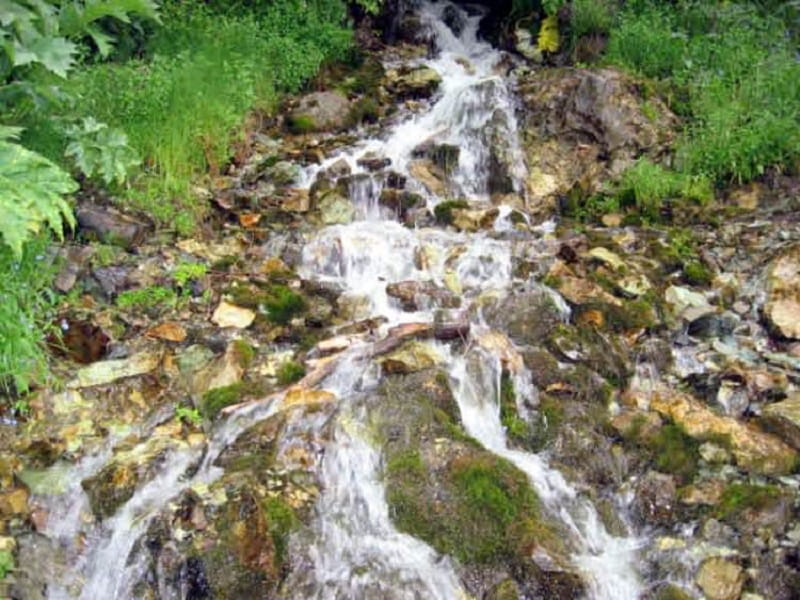
The Culture of Shahrastank
After a widespread fire in 1993, most of the village houses in Shahrastank were burned down, and with a decreasing population, the houses were abandoned and left in ruins. Only permanent residents of the village undertook the reconstruction of their homes, while others were left in their current state due to rural migration. Although most of the burnt houses are repairable, the low income of the villagers and the high costs of restoration have led to migration or non-repair of the houses.
The population of this village, based on the latest census by the Statistical Center of Iran in 2016, was 1,307 people (482 households). However, it’s important to note that the population of the village varies in different seasons of the year. Agriculture is the main occupation in Shahrastank, and in addition to farming, people are engaged in animal husbandry, dairy production, grain cultivation, beekeeping, and carpet and shawl weaving. The people of Shahrastank are Muslims and speak both Farsi and Mazandarani.
Hossein Kariman writes in the second volume of the book “Qasrane Koohsaran”:
“The ancient Qasran region includes areas such as Lavoshan, Feshm, Shemshak, Gajereh, and the mountainous villages of Tochalal to the western regions of the Jajrud River. The common language of the people of Qasran is a dialect of the ancient Pahlavi language, which is a mixture of Tabari or Mazandarani, rooted in ancient Iranian languages, and influenced by Arabic and some Turkish. Additionally, it has been influenced by Dari (Persian) during the Islamic centuries. The closer they are to Mazandaran, the more the Mazandarani dialect predominates in proportion. In areas like Migoun, Shahrastank, Lalan, Zaygan, Ruteh, Garmabdar, Shemshak, and Darband Sar, the Mazandarani language dominates.”
Souvenirs of Shahrastank
Walnuts, various fruits, honey, dairy products, medicinal herbs such as pennyroyal, mountain mushrooms, carpets, and shawls are among the souvenirs of Shahrastank. It’s interesting to know that the people of Shahrastank, in addition to consuming fresh apricots, sun-dry them along with apricot pits seasoned with salt, calling it “Paleh,” and enjoy them as snacks. Don’t miss out on buying apricot leaves when visiting Shahrastank.
The Culture of Shahrastank
After a widespread fire in 1372, most of the village houses in Shahrastank were engulfed in flames, and with a decrease in population, the houses were left abandoned and in ruins. Only permanent residents of the village took on the task of renovating their homes, while the rest of the houses were left to their fate due to rural migration. Although most of the burned houses are reparable, the low income of the villagers and the high costs of restoration have led to migration or neglect of house repairs.
The population of this village, according to the latest census from the Statistical Center of Iran in 1395, was 1,307 people (482 households). However, it’s essential to note that the village’s population varies in different seasons of the year. Gardening is the primary occupation of the people of Shahrastank, and in addition to that, people are engaged in animal husbandry, dairy production, grain cultivation, beekeeping, and the production of jajim and shawls. The residents of the village speak Farsi and Mazandarani and are Muslims.

